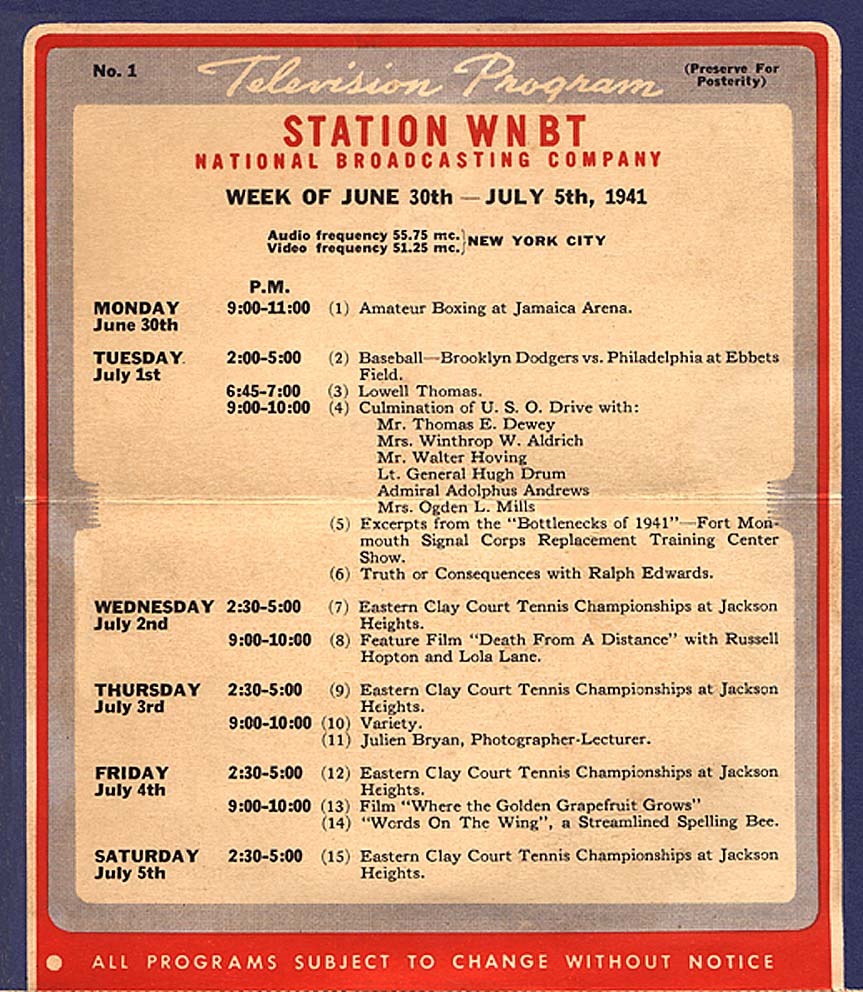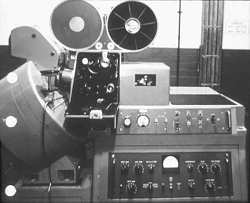Low tech: how to record a TV show if the tape has not yet been invented
 A significant part of modern television is the broadcast of a previously prepared video. TV fragments are glued together with advertising inserts, and the stream of content can be watched almost around the clock. Much less live, when what is happening on the screen is broadcast in real time, and not in the recording. Live broadcast is expected except in news releases and broadcast sports competitions. We are so accustomed to such an order of things that when we broadcast live we are warned about it on the screen with a special inscription.
A significant part of modern television is the broadcast of a previously prepared video. TV fragments are glued together with advertising inserts, and the stream of content can be watched almost around the clock. Much less live, when what is happening on the screen is broadcast in real time, and not in the recording. Live broadcast is expected except in news releases and broadcast sports competitions. We are so accustomed to such an order of things that when we broadcast live we are warned about it on the screen with a special inscription.At the dawn of television, the situation was completely opposite: a lot of live broadcasts, few records. Not only news and sports competitions, but also many TV shows and movies, were often broadcast live. Therefore, we can judge about many of them today only from photographs and descriptions - not a single record has been preserved. Few people saw the need to save these fleeting experiments. And the most important reason - telescript technology simply did not exist.
But the way to save video is needed not only to transfer knowledge to descendants. It is necessary to somehow transmit the picture to other countries or within the country to other time zones. There was no satellite connection or tape. How to record a TV program?
')
The result of the simplest solution to this problem is familiar to the avid fans of Doctor Who. It is necessary to charge the camera with a 16 mm film, direct it to the TV screen and shoot. That is what they did before the seventies of the last century.
Image to kata: One of the first television programs for the period from June 30 to July 5, 1941, 75 years ago. In the early years of the development of television, there were few viewers and hours of broadcasting. The programs were usually distributed in newspapers or delivered separately. Specifically, these cards were sent to all owners of television sets in New York and the surrounding area. (At that time, there were fewer than 7,000 working televisions in the United States.) As you can see, the list is mostly live. tvhistory.tv .
In the United Kingdom, recording a movie on a TV screen is called telerecording. In the United States, recordings of television programs from a kinescope tube were called kinescope recordings, but later reduced to kinescope and even kine / kinne.
In the thirties of the last century, they began to run around this seemingly primitive decision. But it is not enough just to put a movie camera in front of the TV. The fact is that every frame of the film is exhibited in the camera. Then it is shifted by the grab mechanism, while the source of the image is blocked by a obturator. The next frame is displayed, the process is repeated. The cycle occurs 24 times per second. The cathode ray tube of the TV 25 or 30 times per second updates the image on the screen. Rather, the screen updates the TV fields or half-frames 50 or 60 times per second.
Watch Mr. The Wizard explains to children the phenomena that underlie the work of everyday objects. High ambitions of educational television programs and low amounts of affordable funding led to an understandable decision in the choice of broadcasting method. By 1954, 14 television stations broadcast live, another 77 - from the screen recording films.
The first experiments looked like eight frames per second recording without sound. It turned out roughly and pulled. By the mid-forties, the process was improved, sound appeared. The method was widely used in 1946.
Installation of the American company RCA. tvhistory.tv
To obtain 24 fps from 30 in the American standard, the following scheme was used: the frame was exposed to 1/30 of a second, and then shifted in 1/120 of a second. The shutter at 288 ° open area made 24 revolutions per second. As a result, 48 half-frames or 24 frames remained on the film, and 12 half-frames or 6 frames were dropped.
The loss of 6 frames was not without problems. Sometimes there were so-called splices when a white or black line appeared between the TV fields when the synchronization failed. These problems were solved by various tricks: rejection of half-frames, Moye-Mechau systems and so on. Some installations wrote 30 frames per second, which eliminated some problems.


Left: installation with suppression of the half-frame. Right: installation with a drum of Mechau mirrors and a Moye camera. bbctv-ap.co.uk .
Videos were written either on 16 mm or 35 mm film. The first option was cheaper and demanded much less film footage, but the second was better suited for repeated broadcasts to the whole country. In some systems, the sound was written on the same film, in some - on a separate magnetic tape. The resulting picture quality was expectedly bad. Grain, blurring and even distortion are frequent signs of such a recording. However, analogues simply did not exist, and did not have to complain.
There is a great practical necessity in recording the broadcast. Of course, home sales in those years had not yet thought about it - we are talking about the internal needs of the studios. If the program needed to be re-broadcast or to provide it with another settlement, it was necessary to resort to film. When broadcasting in different time zones, the recordings were delivered: from the telecentre to the telecentre. Some advertisers have required to demonstrate that their video was shown in the right place. Therefore, sometimes decades later, interesting films were found in the archives of advertising agencies.
October 7, 1947, the earliest of the surviving records of British television.
In some cases, broadcast recordings were recorded repeatedly. The British supplied the Commonwealth of Nations (their former colonies) with records of important events, such as the royal wedding. By the way, the wedding of Elizabeth II and Prince Philip is one of the earliest surviving recordings of television.
The plane of the Royal Air Forces with a tape of a telecast recording arrived from Britain to Canada where event broadcasting was conducted to all North America. In San Francisco, another film was removed from the screen and sent to Australia. The original picture in 405 lines of the British standard went on film and was broadcast in 525 lines, then again on film and on the TV screen in 625 lines. The final quality was terrible, but it was possible to supply several countries with video recording of the event some 18 hours after it.
Comparison of the original tape and film recording from the screen.
This showed one of the advantages of telerecording: no need to think about the differences in broadcasting standards of different countries. You can also sell a black and white color broadcast film to a television center that does not yet broadcast in color. The telerecording system almost did not catch the color, since by the time color television began to spread, tape recording systems had become more accessible.
By 1956, Ampex was sharpening the technology of video recording on magnetic tape, gradually the novelty began to gain momentum. The first entries were expensive - a watch reel cost $ 300. In today's money it is $ 2700. The magnetic tape slowly crowded out the film, although “kinescopes” remained the industry standard for storing video for a long time.

The only remaining recording of the 1953 British series The Quatermass Experiment is a film, where an insect is sitting on the screen in half of the second series.
Almost all the television of those years was lost forever, much was not recorded at all. If they were, magnetic master copies were often overwritten by new gears. And not only from saving expensive magnetic tape, but also because of the conditions of the contract with the actors. Before the invention of reliable recording methods, re-broadcasting a television show meant re-hiring the same actors and re-playing. In the era of TV recordings, it became possible to broadcast the same copy indefinitely, which upset the acting unions. Therefore, in some places the number of re-broadcasts of one telecast was limited. Or, the deductions for re-broadcasting were deliberately prohibitively high — it’s cheaper to shoot something new.
It is the “picture tubes” that need to be thanked for the miraculously preserved footage: recordings on an expensive magnetic tape are more practical to destroy by mashing to reuse the media, and there is no such use case for films. Although the film did not care. For example, after the DuMont Television Network was closed in 1956, the archives of the television network were dropped into the Bay of New York.

Installation for recording television on 16 mm film. This copy worked alongside VCRs. www.vtoldboys.com .
Thanks to telerecording, some of the first seasons of “Doctor Who” have come down to us, whose magnetic recordings have been erased. Kinescoping retained many soap operas, which were filmed live until the mid-seventies. Kinescoping saved the moon landing footage that NASA lost.
Record of Apollo 11 landing on the moon
Today, telerecord and “kinescopes” can be found only when referring to historical records. A third generation of people is growing up that has never met this phenomenon. Fortunately, those who are interested in the historical value of the recording, do not scare away a small amount of noise, debris and grain in the picture.
Source: https://habr.com/ru/post/395745/
All Articles